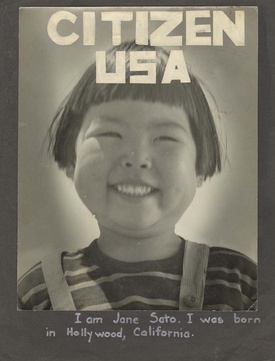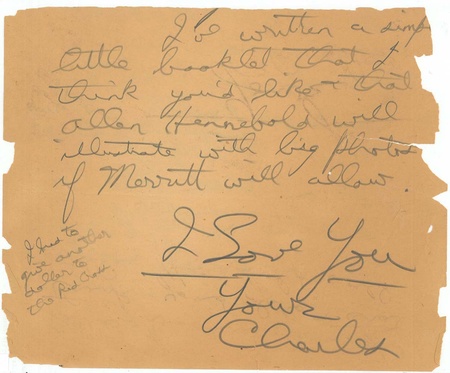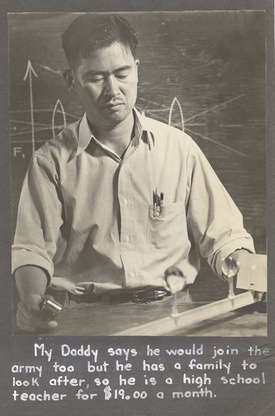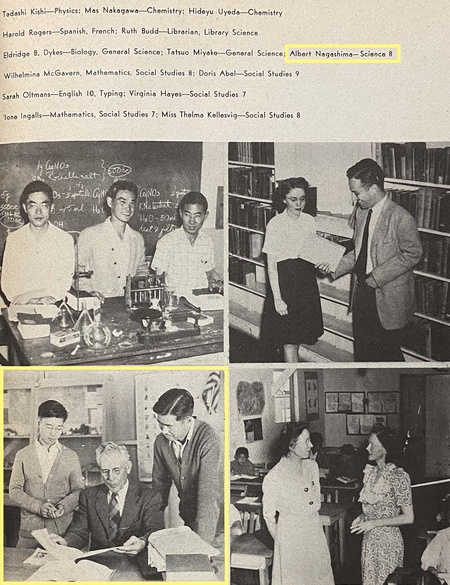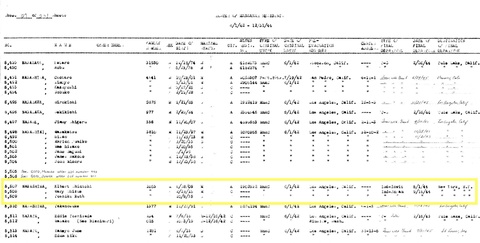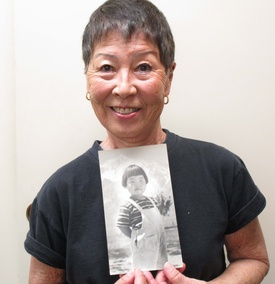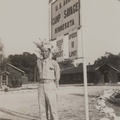The release of the book Citizen USA by the Japanese American National Museum has been over 75 years in the making. Written at the Manzanar concentration camp between 1942 and 1943 by the Director of Adult Education, Charles K. Ferguson, yet never released at the time, the unpublished manuscript was donated to JANM by Charles Ferguson’s wife, Lois, in 2002. This unique work, unseen for decades, was recently shepherded through the publication process by Maria Kwong, JANM’s Director of Retail Enterprises. With the Fergusons since having passed away, it was up to Maria and JANM Collections Management staff to research and prepare the work for release and, in doing so, discover the story behind Citizen USA.
* * * * *
The 22-page book titled Citizen USA comes to life as a combination of professional photograph prints and minimal, handwritten text. On the surface, the story follows a young girl named Jane Sato as she introduces herself and her family, and explores Manzanar with them. The reader learns of her father Elbert’s life before and at camp as a teacher, and meets her two uncles: one who has joined the military to fight for American democracy; and another uncle who now questions his faith in it.
But throughout the pages, as the playful main character guides readers to different locations around Manzanar, Ferguson, writing from the viewpoint of the young Jane Sato, explores not only the difficulty of incarcerated life, but also the racism directed at Japanese Americans and their fears regarding resettlement and life beyond camp.
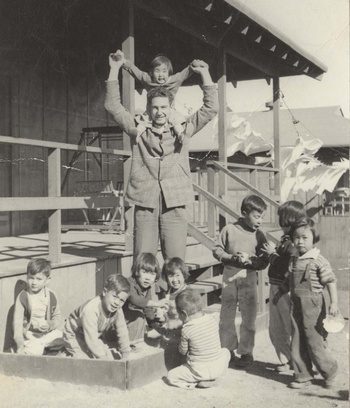
It was this perspective that made the work unique for its time and called into question, at least for its author, whether it would be published. In a wartime-era letter donated to JANM a year after Citizen USA’s donation, Ferguson writes to his wife Lois that he thinks she’ll like the “little booklet” and hopes that Manzanar’s Project Director Ralph Merritt will approve his manuscript for publication.
Unfortunately, for unknown reasons, Charles Ferguson was never able to publish his work. It remains uncertain if Merritt ended the project, or if Ferguson’s departure from Manzanar in 1943 to join the military kept him from finalizing its publication. If not for Lois Ferguson’s donation in 2002, the manuscript might be altogether lost.
In 2002, Lois Ferguson reached out to JANM’s curators to offer artifacts that belonged to her late husband Charles Ferguson, including Citizen USA. The historical value of the artifact was immediately realized, and its potential for exhibition was noted. The artifact was even highlighted in the museum’s newsletter. It was then that Maria Kwong first took notice of the work.
With its large photographs and text from a child’s perspective, Citizen USA was essentially a children’s book, and Maria believed it might be the earliest written work of that genre to present the Japanese American incarceration experience. But it was not until the artifact resurfaced in 2018, in the process of identifying new ideas for the JANM Store in conjunction with future exhibition research on youth in America’s concentration camps, that Maria was able to finally see Citizen USA published.
Like most artifacts donated to JANM, Citizen USA was located in the 7,200 square foot storage area of the collections department. Housed in an archival folder and protective box, each page of the manuscript rested in between sheets of acid free paper. Designated as object 2002.174.2, Citizen USA rarely emerged from its box in the intervening 16 years. But as collections staff prepared for an exhibition on the experiences of children and teens in camp, the artifact was once again being looked at by JANM staff.
It was at that time that JANM’s archivist, Jamie Henricks, and collections assistant, Shawn Iwaoka, began to research the artifacts’ origins and were naturally curious about Jane Sato.
Their first question was “what happened to Jane Sato and her family?” Jamie and Shawn looked into Manzanar’s Final Accountability Roster (FAR) for clues about the Sato family. The FAR records, recorded by the War Relocation Authority, list incarcerees in large books for each camp, organized by family name. The records are dense with family information, including family numbers, birth dates, hometowns, and other details. More importantly, for the purposes of their research, the FAR records provide the relocation destination for individuals leaving camp.
However, the Manzanar FAR record did not list anyone named Jane, Elbert, or Mary Sato. With one dead end, the next step was to identify clues that could pinpoint other family members. Jamie noticed that the book’s text mentioned Elbert Sato was a high school teacher at Manzanar, earning $19 per month. This prompted a frantic search for a copy of a Manzanar yearbook in the museum’s archives. Her hunch paid off: among the photos of faculty, a man who looked like Elbert Sato was identified in the caption as “Albert Nagashima”. Although this was a different name entirely, it gave Jamie a new name to return to the FAR records with and hopefully to provide information on the family in the story.
Their digging paid off when Jamie soon discovered the Nagashima family in the records. Curiously, the first name listed was “Elbert Nagashima,” which most likely meant the Manzanar yearbook caption was a typo. Below “Elbert” was the name “Mary”, but most importantly, below that name was “Ruth Nagashima.” Could this be Citizen USA? Jamie and Shawn had made a breakthrough in their research and could now use that name in a Google search and hopefully make contact with present day Ruth, Citizen USA herself.
With this new name and additional details in the FAR record such as the notation that the Nagashimas left Manzanar for New York City, Jamie was able to find a search result for a New York high school alumni magazine with a “Where Are They Now?” column which mentioned Ruth. This website provided new details about Ruth, including her married name, which allowed Shawn to update the online search, and find contact information for people related to Ruth.
Their research now placed them only a phone call away from answering their initial question of “What happened to Jane Sato and her family?” Shawn Iwaoka pointed out, “We’ve gone from Jane Sato, to Ruth Nagashima and now have her present day name and potentially a way to contact her. And all of this is connected together by the Citizen USA artifact, a Manzanar yearbook and the Final Accountability Roster, and the presumption that the real-life Nagashima family fits the description of the fictional Sato family. It’s a lot of archival and collections research and sleuthing, good old-fashioned clues, and some reasonable hunches.”
Eventually, the Collections Management team and JANM’s Chief Curator, Karen Ishizuka, were able to speak with Ruth over the phone. They discovered that she and her family had not seen the Citizen USA manuscript Charles Ferguson had written decades before, but the family was sent a copy of the images contained in the manuscript shortly after resettling in New York.
Most surprising was the discovery of Ruth’s life and work in her later years. Equipped with the images sent to her family after their move to New York, Ruth put together a presentation centered around the very photographs seen in Citizen USA of her as a child incarcerated at Manzanar, and was giving talks on America’s concentration camps.
As Shawn Iwaoka mentions in the video The Story of Citizen USA, “It was really something else to realize from speaking with [Ruth] that these photos had had this whole other life to them. The photos are taken and developed at Manzanar, and then one set stays with Ferguson and returns with him to Los Angeles and eventually are donated to JANM as part of Citizen USA, and another set around the same time is developed at camp and like the Nagashimas travels across the country and literally resettles with Ruth and her family in New York to have this whole other existence and story.”
With the research completed, and contact made with Ruth, Maria Kwong was finally able to see her hope for publishing Citizen USA come to fruition. With an introduction by Karen Ishizuka, Citizen USA is printed in its entirety as a book that will hopefully teach children about the Japanese American camp experience. By presenting hard truths and difficult circumstances from a child’s perspective with questions like “Isn’t America still democratic?”, Citizen USA is still as relevant as it was when it was first written.
Sadly, Ruth Nagashima Braunstein passed away on July 14, 2020. We are grateful that we were able to uncover her story before she died.
* * * * *
Copies of Citizen USA can be purchased at the JANM Store.
To learn more details about the research into Citizen USA, watch The Story of Citizen USA with JANM’s Collections Management staff Jamie Henricks and Shawn Iwaoka.
© 2020 Shawn Iwaoka and Jamie Henricks



